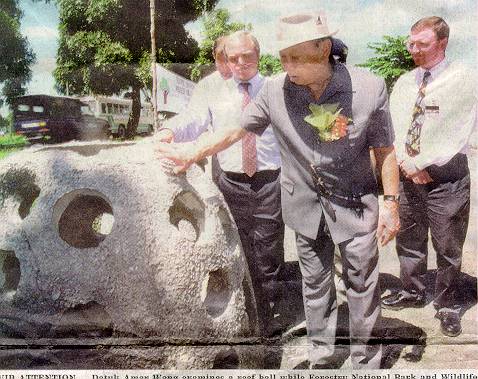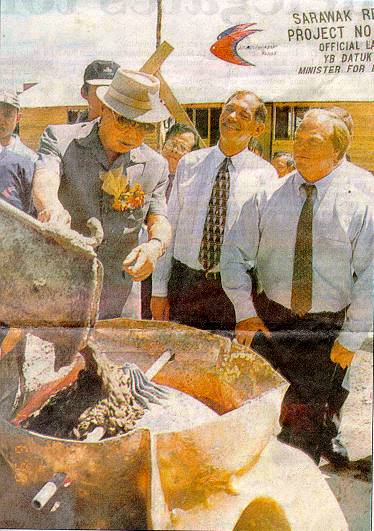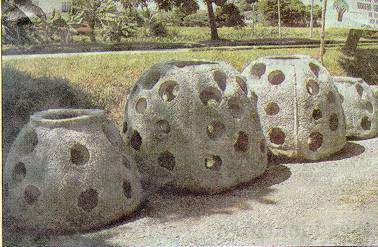Malaysia Reef Ball Artificial Reef Project
With permission, from "Sarawak Tribune", Front Page, Thursday, June 18, 1998
Sarawak scores Asian First in marine life conservation
By Fraser Barui
KUCHING - Sarawak has become the first in Asia to use environment-friendly American-manufactured "Reef Balls" to conserve its marine life - turtles in particular. Yesterday, the Sarawak Reef Ball Working Group Project 1 (Talang-Talang Region) was launched amid high hopes that marine life conservation in the State would be greatly enhanced by the US technology. Environment and Public Health Minister Datuk Amar James Wong was proud to note that the various government agencies had been able to coordinate a planned attack on the threats to marine life.
"We now have the opportunity to start a model for the rest of Asia in planned and responsible marine conservation," he said at the launching ceremony. "The Reef Ball project and the formation of the Sarawak Reef Ball Working Group are carried out to oversee all proposed reef projects in the State and ensure a coordinated approach to marine life conservation."
The Group consists of representatives from the Environment and Public Health Ministry, Tourism Ministry, Social Development Ministry, the Turtle Board, the Marine Fisheries Department, the Sarawak Museum, the Sarawak Tourism Board, the Marine Department, the Natural Resource and Environment Board and the Forestry Department working in collaboration with the Reef Ball Development Group Limited, Florida, USA.
For Project One, 1,500 reef balls of different sizes will be placed in the Talang Talang region this year. Other selected areas, including Similajau in Bintulu, have also been identified for the project, depending on funding and the results of the first project. Datuk Amar Wong disclosed that the Environment and Public Health Ministry had allocated RM300,000 for the Talang Talang project.

VIP ATTENTION ... Datak Amar Wong examines a Reef Ball wihle Forestry National Park and Wildlife Marine Biologist, Mr. Ian Buter (right) and a trainer from Reef Ball Development Group, Mr. Larry D. Beggs.
On reef ball technology, he explained: "Unlike other artificial reefs and barriers, such as barges, tyres and used car bodies, which are found to be detrimental to marine environment and life, reef balls constructed from fiberglass molds, using cement with the same pH as natural sea water, contain no toxins or biologically active compounds.
Datuk James Wong pointed out that it was not the State government's intention to make life difficult for fishing trawlers. "These reef balls are only meant for areas like Talang Talang and Satang Islands and other areas that need protection to conserve the marine life in the vicinity and the environment as a whole," he said.
He hoped more companies would come forward to sponsor the manufacturing of Reef Balls.
With permission, from "The Borneo Post", Front Page, Thursday, June 18, 1998
Reef Ball project to protect turtles
KUCHING, WED. Special 'mines' will be strewn at random on the sea floor around Talang-Talang and Satang Islands to deter fishing trawlers from practising illegal trawling activity there.
These environmental-friendly and non-toxic "Reef Balls" are part of the measures adopted by the State government to give some protection to the turtles around the Islands, said Environment and Public Health Minister Datuk Amar James Wong Kim Min.

The Minister (L) being shown how the Reef Balls are moulded
by Harry Rolfe (C) and Larry Beggs (R) of the Reef Ball Development Group of
the United States
Speaking when officially launching the "Sarawak Reef Ball Working Group" Project I (Talang-Talang Region) this morning, he said Sarawak is the first Asian country to use the reef balls and it could be a model for the rest of Asia in planned and responsible marine conservation.
The Reef Balls are invented and manufactured by the Reef Ball Development Group Limited of the United States, a non-profit organisation helping to restore the world's ocean ecosystem. Wong said the sea turtle population has declined at an alarming rate of 95 percent over the last 35 years.
The species of marine turtles found in Sarawak are the Green Turtle, the Hawksbill and the Olive-Ridley and their populations have stabilized recently showing that past conservation efforts are beginning to bear fruit.
"Illegal fishing trawling activity is the largest culprit responsible for killing so many turtles and patrols against such activities are not effective at all. The truly effective way to deter these illegal trawlers is to seed the sea bed around the Islands with some artificial barriers that will act as "mines" to rip their nets apart. This is a more effective as a deterrent measure of enforcement rather than "band aid' tactic of trying to catch them after they have entered the protected areas and may have already killed one or more turtles."
In the past, old car bodies and cement structures were used but such artificial barriers contain heavy metal toxins and chemicals that can kill marine life.
They are also not stable on the sea bed, being tossed around like pebbles clue to the strong wave action and the currents.
The Reef Balls, on the other hand, are constructed from Fiberglass molds using cement with the same pH as salt water and containing admixtures and micro silica.
They remain stable on the sea bottom even in hurricanes as the materials used are dense, of moderate to low profile and designed in such as way that more than half of its weight is in its bottom on the sea floor.

The Finished Reef Balls
They have a variety of rough surface textures and they will effectively cut any trawler's nets when they are caught up by the trawler.
They also have holes in them to create vortexes, and the large space in the centre provides shelter for the fish while the surfaces enhances the settlement of marine life.
The reef balls are expected to last at least 500 years and will hopefully help put the population of marine turtles to full recovery by the year 2010.
Manufacturing of the Reef Balls have started, with each reef ball requiring 28 days for the cement to cure fully and 300 balls will be ready for laying within the next two months. This will be followed a month later by another 200 balls.
The Group will then conduct a scientific survey to study the effectiveness of the first project before embarking on a follow-up project a year later.
The ministry will fund the initial project costs of RM300,000, Wong disclosed. He however appealed to companies and corporate bodies to sponsor the materials for subsequent reef ball projects, so that the areas of coverage can be extended to other marine parks.
Meanwhile, Wong said it was not the intention of the State government or the Forestry and Wild Life Department to make life difficult for the trawlers as the reef balls are only meant for areas like Talang-Talang and Satang Islands, or other areas which needed protection in order to conserve marine wildlife, particularly the turtles.
"The trawlers still have a big area of the open sea where they can trawl, so we are not endangering their livelihood." he said. -BP
With permission, from "Sarawak Tribune", Front Page, Thursday, June 18, 1998
Drastic drop in turtle landings
By Roger J Duyong
KUCHING - Sarawak turtle islands have witnessed a drastic drop in turtle landings over the last 35 years. "Last year, there were 280,000 turtle landings with about one million eggs collected. Thirty-five years ago, three million landings during a season would be common," local expert Dr Charles Leh revealed yesterday. This year, the population. of turtles, which include the hawkbill and olive ridley species, are ex pected to range between 600 to 1,000, depending on the weather, according to Dr Leh. The number of turtles began to decline during the war when hundreds of bombs were dropped in many of the landing areas, killing numerous turtles. After the war, the population did not increase and it was until lately that the turtles were showing signs of a comeback. Previously, the methods used to create reefs for marine life conservation in volved structures like car bodies, lyres and barges which contained heavy metal toxins and other chemicals, believed harmful to the turtles. Moreover, siltation had caused the habitats of the turtles to become shallow. But the chief threats are still heavy fishing and hunting, particularly by illegal trawlers. Dr Leh said to prevent the turtles from extinction, the government had enacted a law to make them an endangered species Measures had also been taken to deter trawlers from catching the turtles. However, some of the anti- poaching methods used were not satisfactory, prompting the authorities to try a new technology from the US called "Reef Ball." Dr Leh hoped it would help to solve the problem. The "Reef Ball" technology is now being applied around the turtle islands of Talang- Talang in the South China Sea.
Copyright ©1995 & 1996, 1997, 1998 RBDG, Ltd. All rights reserved. See brochure page footer for information on patents, copyrights, trademarks and service marks referenced, but not indicated, on this page.